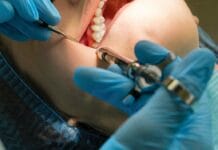As a practicing hygienist, how many patients could you say are victims of gingival recession? I can honestly say that at least half of the patients I treat have some degree of recession. Many of them do not even know what recession is. They only understand the sensitivity that they feel as they drink or eat anything cold. Are all these gingival recession cases due only to aggressive tooth brushing? Knowing the causes of gingival recession, which can include oral anatomy, such as malocclusion or misalignment, or lifestyle choices, is crucial. Determining the causes can make the difference in educating your patients. Determining the causes will also allow you to discuss effective treatment options, both conservative and invasive, and lifestyle choice changes with your patients.
Let’s get into some of the causes of recession. Some factors may be controlled through lifestyle choices. However, others could be genetic factors and predispositions.
Gingival recession caused by lifestyle choices
Medium or hard bristled toothbrush use: The first lifestyle choice that should come to mind is the type of toothbrush used and brushing technique of the patient. If an adult patient is using a hard-bristled toothbrush, using a horizontal scrub method, and they’ve been doing this since the age of 15, you most likely will see some wear or abrasion, and a degree of recession.
Educate on changing not only their way of brushing but also the type of brush they are using. Home care instructions on proper brushing technique, making sure to include “why” a certain method of brushing is better over horizontal scrubbing, can help drive the point home. You can also suggest they use an electric toothbrush. An electric brush can help control the amount of pressure used while brushing and control the speed of the brush leading to less of a scrubbing motion.
Acidic foods/drinks: Ask the patient if they sip on acidic drinks or eat a lot of acidic foods. Pathogenic bacteria favor an acidic environment; giving disease-causing bacteria an environment to thrive, especially if proper home care is not practiced. This can pose a risk for periodontal disease or exacerbate infection already present. Of course, with periodontitis, loss of attachment is a result, which can lead to a patient’s sensitivity.
Acidic food and drinks can also cause erosion which can lead to sensitivity; enamel begins demineralizing around a pH of 5.5. If a patient already has exposed dentin due to gingival recession, exposed dentin begins demineralizing at only a pH of 6.5. This can not only lead to dental decay but sensitivity. According to the ADA, “beverages with a pH of less than 4.0 are potentially damaging to the dentition1.” Considering that Coca-Cola Classic has a pH of 2.371 and Minute Maid Orange Juice has a pH of 3.821, sipping on these drinks can be detrimental to enamel and dentin integrity.
Recommendations for patients who consume acidic food and drinks should be to wait 15-40 minutes before brushing their teeth to allow saliva to neutralize the mouth. Drinking acidic beverages through a straw can help lessen the amount of acidic liquid bathing the teeth. Instead of sipping acidic beverages or snacking on acidic foods over long periods throughout the day, consuming them in one sitting, all at once, can help lessen the acid challenge as well.
Proper homecare: With periodontitis comes tissue destruction, including gingival recession, which can lead to sensitivity. Enforcing proper homecare is an obvious part of dental hygiene treatment. However, giving patients the “why” behind homecare recommendations instead of just saying, “Brush or clean interdentally regularly,” is more likely to lead to a patient having an “ah-ha moment.” When patients understand the “why,” they are more likely to become compliant with hygiene recommendations, which leads to better patient outcomes.
Based on a patient’s understanding level, explain the disease process as it relates to virulent bacteria. Learn what a patient’s barriers are in regards to proper home care. Based on this, in your home care recommendations, individualize techniques and the use of home care aides and products based on each patients’ personal needs. For example, if a patient doesn’t care for string floss for whatever reason, give them other options that they are more likely to use. Maybe the recommendation of using interdental brushes, or another interproximal cleaner, will lead to greater compliance.
Gingival recession caused by malocclusion
A patient with severe Class II or Class III malocclusion may have gingival recession. Most of this recession can be aggravated by a severe overbite and or underbite. The continuous force from misplaced teeth can cause forceful recession that can happen very early, sometimes as soon as patients reach their teenage years.
Another factor that ties into malocclusion is crowding. Crowded teeth can cause recession, but is mainly seen localized to the area in which the crowding occurs. You can discuss orthodontic treatment with all patients with these complications as a solution.
Gingival recession caused by parafunctional occlusal forces
This subject could be an entire article, or even multiple articles, in itself. This article will touch on a few points to keep it brief.
Parafunctional occlusal forces can cause attachment loss, including gingival recession, and bone resorption. Parafunctional occlusal forces are when teeth make contact outside functional activities such as when chewing food. These parafunctional forces place excessive pressure on teeth and periodontal tissues. Parafunctional occlusal forces include biting fingernails, chewing on the buccal mucosa or lips, and of course, bruxism and clenching.
For patients with recession caused by the occlusal forces of nail-biting, behavioral modification is key. When feeling the urge to bite on nails, replacing the habit with something else, like squeezing a stress ball, playing with silly putty, or anything to keep hands away from the mouth, can help. Knowing the trigger to biting nails is important so these triggers can be avoided. Keeping nails short and using bitter tasting nail polish can aid in gradually breaking the habit as well.
Alleviating bruxism and clenching isn’t as clear-cut. Occlusal adjustments are one way to aid in proper occlusion. Oral appliances (night guards) can be used by patients to lessen the forces on the periodontium. However, oral appliances are a double-edged sword; while they aid in lessening the forces on the periodontium, they are a palliative treatment and don’t address the definitive cause of the clenching or bruxism.
There are other downfalls to oral appliances as well. Patient compliance can be an issue. Plus for patients who brux or clench during the day, wearing an appliance isn’t aesthetically pleasing to some. Soft, full coverage appliances may cause worsening bruxism in some patients, so they should only be used short-term2. Maxillary, full coverage appliances pose a risk of aggravation of respiratory disturbances3. There is also the potential for tooth movement and occlusal changes with those who wear oral appliances. One study, though small, looked at the NTI, an anterior coverage appliance, and found tooth movement in 7 out of 10 of the participants using the appliance as compared to using a stabilization splint; one of which reported “impaired occlusion” at the 6-month follow up of the study4.
What is the cause of bruxism? One possible trigger for sleep bruxism could be airway related. An article by Dr. Steven Lin gives a good overview of upper airway resistance syndrome. Another article regarding screening pediatric patients for sleep-related disorders, by Spring Hatfield, RDH, can be found here.
Regardless of the cause, clinical signs of bruxism and clenching are wear facets, attrition, abfraction, tooth mobility, fractured teeth, scalloped tongue, and tori/exostosis. Patients may also report headaches and TMJ pain.
Other causes of sensitivity
There are other causes of tooth sensitivity not discussed here. Some include cracked teeth or fractured roots, decay, and recurrent decay around restorations. Whitening can also cause sensitivity. If patients struggle with sensitivity due to whitening, a good recommendation is for the patient to use sensitivity toothpaste 2-4 weeks prior to whitening.
Treating gingival recession and the sensitivity it may ensue
Along with the treatment options discussed earlier, there are other options to help alleviate recession-caused sensitivity for our patients. Over-the-counter products, such as sensitivity toothpaste that contains potassium nitrate, can help alleviate discomfort. Stannous fluoride can also help with sensitivity. It’s important to educate patients on the need to use sensitivity toothpaste consistently, as a one-time or once in a while use won’t alleviate sensitivity.
Prescription-strength fluoride toothpaste is another option for controlling sensitivity issues. Tooth creams containing fluoride and hydroxy apatite or calcium and phosphate are options as well. Fluoride trays used by the patient at home are another option.
Non-invasive, in-office treatments can help relieve sensitivity for our patients. Some of these include fluoride varnish treatment and polishing with a desensitizing paste such as one containing arginine and calcium carbonate. Using a bonding agent on recessed areas that seals the dentin surface can help provide a barrier to stimuli that cause sensitivity as well.
If recession has become more severe and sensitivity is occurring, a more invasive treatment such as a gingival graft may be in order. In either situation, non-invasive or surgical treatment, it is prudent to discuss all options with the patient to make sure they make an informed decision.
Gingival recession will no longer take your patients hostage. No longer will they wonder why their sensitivity is continuously getting worse, and why their teeth are looking “longer” or more yellow. You have informed and educated your patients about their options, how to prevent gingival recession, and its associated causes.
Before you leave, check out the Today’s RDH self-study CE courses. All courses are peer-reviewed and non-sponsored to focus solely on high-quality education. Click here now.
Listen to the Today’s RDH Dental Hygiene Podcast Below:
References
- Reddy, A., et. al. (2016). The pH of Beverages in the United States. The Journal of the American Dental Association. Retrieved from http://www.ada.org/en/~/media/ADA/Public%20Programs/Files/JADA_The%20pH%20of%20beverages%20in%20the%20United%20States.
- Savabi O, Nejatidanesh F, Khosravi S. Effect of occlusal splints on the electromyographic activities of masseter and temporal muscles during maximum clenching. Quintess Int. 2007; 38:129-132. Retrieved from http://europepmc.org/abstract/med/17510715.
- Gagnon Y, Mayer P, Morisson F, Rompre PH, Lavigne GJ. Aggravation of respiratory disturbances by the use of an occlusal splint in apneic patients: A pilot study. Int J Prosthodont. 2004; 17:151-7. Retrieved from https://www.ncbi.nlm.nih.gov/pubmed/15382781.
- Magnusson T, Adiels AM, Nilsson HL, Helkimo M. Treatment effect on signs and symptoms of temporomandibular disorders – comparison between stabilisation splint and a new type of splint (NTI). A pilot study. Swed Dent J. 2004; 28(1):11-20. Retrieved from https://www.ncbi.nlm.nih.gov/pubmed/15129601.












